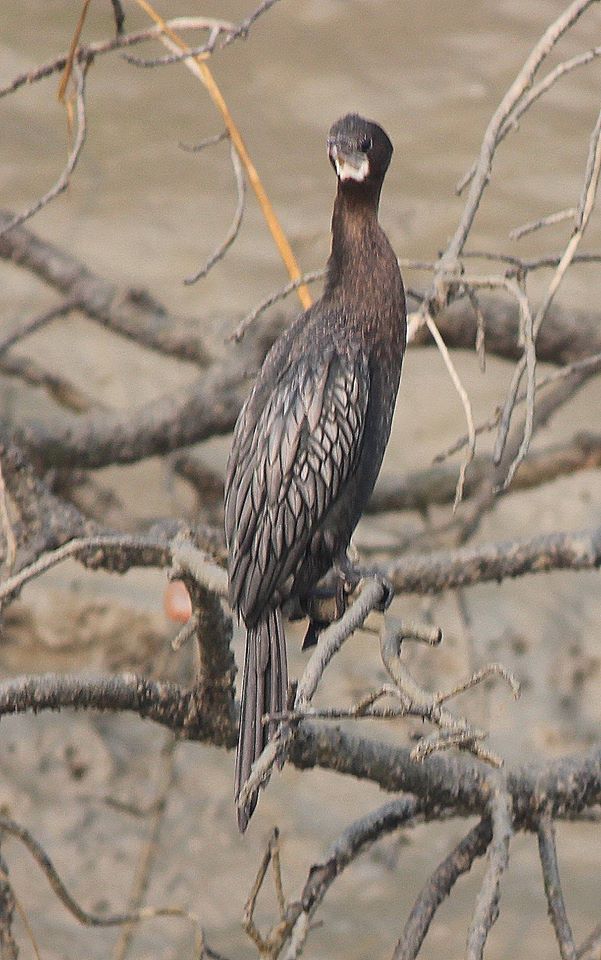
My first brush with cormorants was in a Bengali rhyme ‘পানকৌড়ি পানকৌড়ি ডাঙায় উঠনা’ – ‘Cormorant(Pankouri), O Cormorant stay in the water’ . Interestingly the Bengali moniker connotes a glutton or a diver. There can not be an apter description of this bird’s behaviour – it is a voracious eater and moves around in deep waters like an otter. In Bengal fish farmers lay criss-cross ropes laden with coloured swags above their ponds to keep away the cormorants.
A Satyajit Ray story was my second encounter , wherein Ray talked about how cormorants would use their lungs as ballast tanks as in a submarine to float up or dive into the water. Much later in life did I learn about a US defence department research project in which a submergible aircraft (https://en.wikipedia.org/wiki/Lockheed_Martin_Cormorant) called Cormorant was to be developed. While inside a submarine tube the aircraft’s wings would be folded around itself and while floating up to the surface , wings would unfold in preparation for launch – very similar to the Cormorant Bird’s under-water and in the air movements. Is that Science imitating life !!

Photo Credits Mike Hanlon ( https://newatlas.com/the-cormorant-mpuav/5372/)
My third meeting with cormorants in the world of words was in the least likeliest of places – in a Bond Novel where one would not expect to accost birds with feathers. In “You Only Live Twice” Bond takes refuge in a Japanese fishing community. Fisherwomen out there would not use nets or lines – instead they would use their cormorants for fishing. A snare would be put around the cormorant’s neck to prevent it from swallowing bigger fish. The bird with a fish in its gullet would be brought back to the boat and made to spit the fish out into bin of ‘fresh catch of the day’!!

Photo by Frédéric Lemaréchal, alias Maboko – Originally from fr.wikipedia;
Having grown up in antediluvian pre-internet times , I did not get to see a cormorant in a picture or in flesh and feathers till I hit my early 20’s . From my reads, a certain mystical imagery had developed in my mind about cormorants. Thus the first sighting at Joka marshes (my institute campus in Kolkata) was laced with a sense of underwhelm. Here was a bird with an ungainly body, dull feathers and an awkward low flight. But then it started growing on me – I started noting and marvelling at its aircraft-like take off with run-up ; its landing using its webbed feet as landing gear; the periscope like look of the head with body inside water; the sudden disappearing dive and the equally sudden erupting reappearance 100 feet away. The voyeuristic affair continues – hopefully till …
I am a newbie birdwatcher and get fascinated by the things that seasoned birders would brush off with a knowing smile. Paths of cormorants and mine have crossed a few times but no other meeting has been as unexpected as the one in the heart of a desert at Dubai. It was an artificial lake made with desalinated sea-water. The lake was in a large residential complex. This was not an aviary but a whole eco-system created with desalinated water !! I have recorded bulbuls, cormorants, lapwings, hoopoes in Dubai – most are introduced or vagrant species not native to Dubai.
Collective noun for a group of cormorants is an unusual but fitting word – sunning. Sunning is what a sunning of cormorants needs to keep doing when out of water. A cormorant with its wings spread out in a sunning position is the most photographed pose of the bird

Protagonist of our story, My Cormorant Tree is housed in Rabindra Sarobar , an artificial lake created by the British – a creation as grand as the Victoria Memorial or the Howrah Bridge. I guess it is home to some 500+ cormorants and they regularly compel me to interrupt my walk and watch their antics. That my cormorant tree is thriving in a lake surrounded by a concrete jungle is a most gratifying bliss.

Note : All photos not credited in caption are taken by me – Dev Baul









Beautifully observed details and penned down equally well.
LikeLiked by 1 person
Thank you , Thank you. Appreciate you for taking the trouble of commenting on the site
LikeLike
I’ve grown up listening to you telling tales of the Cormorant aka Pancowrie in Bengali so it’s fitting that your first post is about it. You’ve made a bold move of taking this step and I’m really proud of you Baba!
LikeLiked by 2 people
Well , that is really encouraging – hope to post the next on in near future
LikeLike
Superb writing and equally great photography Dev Baul ! Chhupa rustam with such talent!😄 Ramprasad
LikeLiked by 1 person
Thank you.Did you notice that talent is an anagram of latent
LikeLike
Good stuff, Pratap! Nicely written … I learnt a thing or two from here. Look forward to more …
LikeLiked by 1 person
Thank you . Can not identify from your id kratu9 – please quench my curiosity
LikeLike
is that you Arabinda
LikeLike
Brilliant piece.
LikeLiked by 2 people
thank you
LikeLike
Is that you Shyamalda
LikeLike
This line seems incomplete “The voyeuristic affair continues – hopefully till”. Am I missing something?
LikeLiked by 1 person
Read ‘I kick the bucket’ for the dots that follow till . LOL
Thank you for such attentive reading – you do not miss much
LikeLike
Very well written and the man behind the lens is equally adept with putting his thoughts together. Treat to read this post.
LikeLiked by 1 person
You have displayed a remarkable penchant for words and birds. For “probashi bengalis like me”, the imagery provoked by your “descriptive lyrics”, evokes a nostalgia in me.
Will wait for your next post with great expectations.
LikeLiked by 1 person
Dev – I enjoyed reading the piece very much, and the pix are great too..! This is an explosion of latent talent (to be anagramically accurate), and I look forward to more such. Regards. Anand Sudarshan
LikeLiked by 1 person
‘latent talent’ and ‘Elvis lives’ are my favourite anagrams 🙂
LikeLike
Wonderful post.
LikeLike
thank you
LikeLike
Very well written and thoughts penned down perfectly ..looking forward to the next one
LikeLike
Thank you – hopefully soon
LikeLike